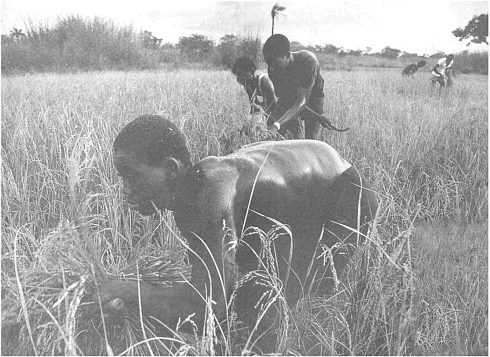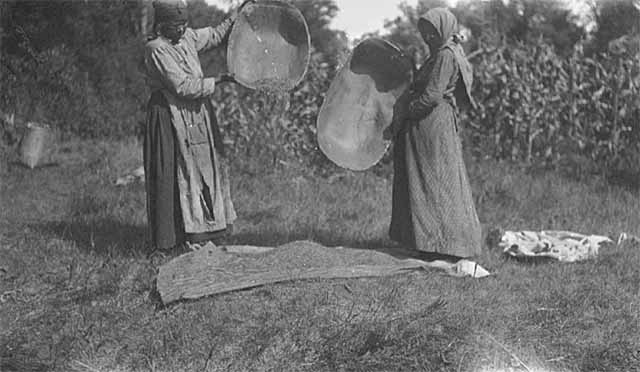
From Slavery in America, "Rice and Slavery: A Fatal Gold Seede," by Jean M. West: -- On New Year's Day, many Americans, especially those with southern origins, eat a dish combining black-eyed peas and rice called "Hoppin' John." It's supposed to bring good luck since people who "eat poor New Year's Day, eat rich the rest of the year." Most would be surprised to learn that rice is not a plant native to the New World. They would be even more surprised to learn that the dish has roots in tragedy rather than in luck. In Alexander Falconbridge's 1788 narrative, An Account of the Slave Trade on the Coast of Africa, he describes food served during the Middle Passage and reports, "The diet of the negroes, while on board, consists chiefly of horse-beans, boiled to the consistence of pulp; boiled yams and rice, and sometimes a small quantity of beef or pork." How did rice come to the New World, and why is its New World history intertwined with slavery?

Ghana West African Rice Fields
Rice of the Old World
Rice is a tall annual grass that grows in a variety of conditions although it flourishes in wet, warm tropical climates. It is an ancient plant whose origins go back over 130 million years, hypothetically when South America, Africa, India, Australia, and India were joined in the southern hemisphere super-continent of Gondwanaland. When the continents broke up, a red rice of the species oryza glaberrima evolved in Africa, while today's dominant crop species, oryza sativa, evolved in Asia. People living along the Niger, Sine-Saloum, and Casamance Rivers began cultivating African wet rice around 2,000 to 3,000 years ago; archaeologists have discovered Asian rice grain imprints dating between 5,200 and 4,000 years ago in northern China, while Asian rice cultivation may have begun several thousand years earlier. It is believed that members of Alexander the Great's army brought the Asian variety of rice back from India, leading to its cultivation in the Mediterranean region, including Spain and Portugal.

Rice Growers in Sierra Leone, West Africa
Portuguese explorers reported African rice fields south of Cape Verde, probably along the Gambia River, as early as 1446. In the 1590s, André Alvares d'Almada reported that West African rice farmers, "construct dikes of earth for fear of the tide, but despite them the river breaks them frequently, flooding the rice fields. Once the rice has sprouted, they pull it out and transplant it...." West Africans learned to grow rice in the Niger River Delta and, from modern Senegal to Liberia, adapted different methods of production to different climatic conditions including tidal floodplains, inland wetlands, rain-fed Guinea uplands, and mangrove swamps along the Atlantic coast. Although different tribal groups divided rice cultivation work differently, women typically sowed the rice (covering the grains with clay before planting), milled rice using mortar and pestle, created coiled-grass fanner baskets to winnow rice as well as storage baskets for the cleaned rice, and cooked rice for their families. The Portuguese introduced Asian rice to Africa around the middle of the 16th century; by the height of the slave trade many Africans were familiar with the techniques of cultivating both the African and Asian species of rice.

South Carolina Low Country Rice Fields
Early Spanish explorers introduced Asian rice to the Caribbean and South America; rice first arrived in Mexico in the 1520s at Veracruz, which was selected for its warm, wet, Gulf climate. Portuguese colonizers and their African slaves introduced Asian rice at about the same time to Brazil.

Tradition says that rice arrived in South Carolina around 1685 when sea captain John Thurber's ship was being repaired in Charleston. Thurber gave a sack of "Gold Seede" rice from Madagascar, a great rice-producing island off the east coast of Africa, either to Dr. Henry Woodward or Thomas Smith, who was a landgrave (governor of a major land grant). However, a bushel of rice had been sent to the colony on the supply ship William and Ralph as early as spring1672. By September 26, 1691, the General Assembly of South Carolina passed an act permitting colonists to pay their taxes in rice, as well as other commodities. According to Edward Randolph, the collector of customs, planters exported 330 tons of rice from Charles Town (Charleston) to England and English Caribbean colonies in 1700; the governor complained that they had produced more rice than there were ships on which to export the grain. While some of the red-colored rice in early South Carolina was the African oryza glaberrima and may have arrived on slave ships, planters quickly adopted two varieties of the Asian oryza sativa, "Carolina White" and the prized, high-yield "Carolina Gold." Rice cultivation was centered in the Low Country of South Carolina, with the Georgetown District emerging as a major production zone. North Carolina's Lower Cape Fear Region (from the 1720s onward), northeastern Spanish Florida, and coastal Georgia (after the 1750 repeal of the Trustee's ban on slavery) also produced rice throughout the colonial and antebellum eras.

Table 1: South Carolina Colonial Rice Exports
1698 | 5 tons
1700 | 330 tons
1726 | 5,000 tons
1730 | 10,000 tons
1740 | 25,000 tons
1763 | 35,000 tons
1764 | 40,000 tons
1770 | 42,000 tons

Many of early settlers of the Carolinas (both the Cape Fear settlers of 1663 and the Ashley River emigrants of 1670) came from Barbados. These experienced sugar planters were offered land incentives to bring slaves; for example, contracts from 1664 guaranteed emigrants from Barbados a bonus of 20 acres for every male slave and ten acres for every female slave they brought to the new colony. However, the Carolinas were too cold for the cultivation of sugar, and the exports of lumber, cattle, and deerskins provided slim profits.

Slavery in the Rice Fields
The English settlers began to enslave the region's Native Americans in large numbers, selling them in the slave trade and using them as laborers. African slaves were imported from the earliest days, as well. In 1671, Sir John Yeamans arrived at the Ashley River settlement (the future Charleston) with 200 African slaves. According to South Carolina's 1708 census, there were 3,000 African slaves and 1,400 Native American slaves in a total population of 9,500. However, smallpox and yellow fever killed many Native Americans and it was impossible to get enough European indentured slaves to provide the colony with adequate labor. Indeed, Charleston merchant Samuel Eveleigh asserted in 1735, "I am positive that the Commodity can't be produced by white people. Because the work is too laborious, the heat very intent, and the whites can't work in the wett at that season as Negrs do to week rice." By the 1730s Carolinian slavery was predominantly African.

From early on there was a close relationship between African slavery and rice cultivation. Planters buying slaves showed some preference for West Africans from the Gold Coast. In An Account on Life in the Carolinas in 1750, Johann Martin Bolzius claimed, "The best Negroes come from the Gold Coast in Africa, namely Gambia and Angolo." In the 1730s, roughly 12 percent of South Carolina's slaves were from the centers of rice-production (the Upper Guinea Coast, Senegambia, and the Windward Coast), but that number rose to 54 percent by mid-century, and 64 percent in the 1770s before receding in the 1780s; averaging 43 percent for the 18th century. Some slave brokers in coastal Africa apparently trained captives in African rice fields prior to selling them to slave traders bound for the Carolinas; the Charleston Evening Gazette of July 11, 1785, advertised "a choice cargo of Windward and Gold Coast Negroes, who have been accustomed to the planting of rice." These African slaves brought knowledge from their homelands of different modes of rice cultivation, soil and water management and milling, which they adapted to the rice plantations of the Southeast, such as using hollow cypress log "trunks" to control the flow of water from levees (embankments) into fields. (source: http://www.slaveryinamerica.org/history/hs_es_rice.htm)

No comments:
Post a Comment